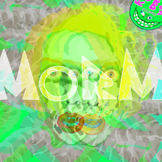A Scat-tera/tological Experience!
SCATTER + TERATOLOGY + SCATOLOGY =
SCAT-TERA/TOLOGY
Think of scat-tera/tology less as another boring descriptor of artistic practice but, instead, more as a mischievous incantation or a wicked spell of necromancy that both summons and ushers the cultural walking dead into the sterile confines of the 'white cube', infecting the sacred solemnity of an art gallery with the bombastic presence of low brow and lo-fi pop. Yet scat-tera/tology's inglorious paean to the ungainly nature of b-grade melodramas, retro movie posters, DIY horror, late-night adverts , illogical graphics and electronic pop music is more than just simple veneration of kitschy culture. Like any good necromantic spell, scat-tera/tology exploits these fabulous products in order to channel the perverted post-humanism that lurks beneath and throbs within their cartoony signage, wherein anything 'human' is seen as just another material to be refashioned and used to achieve a particular affect. Moulded, bloated and completely overloaded by cheap artifice, this exhibition views the human form as nothing more than a vehicle for theatrical thrills and outrageous spectacle. As something fragmented, unbelievable, rough, plastic, grotesque, vulgar and/or lowly. In a word, Scat-tera/tological!
SCAT-TERA/TOLOGY
Think of scat-tera/tology less as another boring descriptor of artistic practice but, instead, more as a mischievous incantation or a wicked spell of necromancy that both summons and ushers the cultural walking dead into the sterile confines of the 'white cube', infecting the sacred solemnity of an art gallery with the bombastic presence of low brow and lo-fi pop. Yet scat-tera/tology's inglorious paean to the ungainly nature of b-grade melodramas, retro movie posters, DIY horror, late-night adverts , illogical graphics and electronic pop music is more than just simple veneration of kitschy culture. Like any good necromantic spell, scat-tera/tology exploits these fabulous products in order to channel the perverted post-humanism that lurks beneath and throbs within their cartoony signage, wherein anything 'human' is seen as just another material to be refashioned and used to achieve a particular affect. Moulded, bloated and completely overloaded by cheap artifice, this exhibition views the human form as nothing more than a vehicle for theatrical thrills and outrageous spectacle. As something fragmented, unbelievable, rough, plastic, grotesque, vulgar and/or lowly. In a word, Scat-tera/tological!




























